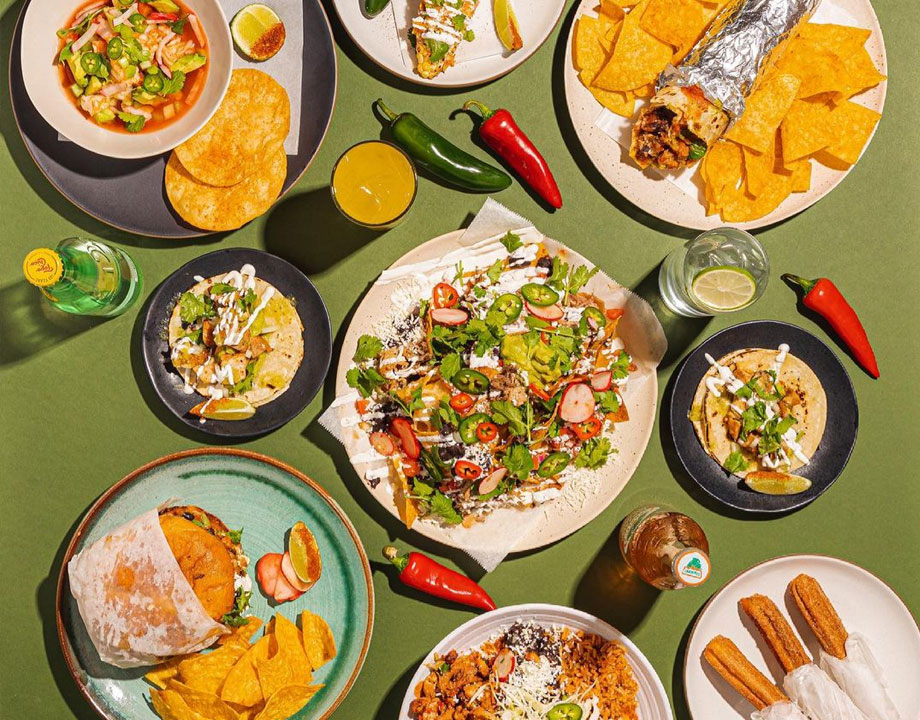A weekend foodie’s list of Best Restaurants across the continent
A weekend foodie’s list of Best Restaurants across the continent
Blog Article
Dining Delights: Check Out Ingenious Restaurants Changing the Food Scene
The modern dining landscape is experiencing an impressive change, marked by cutting-edge restaurants that are redefining culinary norms. From the increase of pop-up facilities welcoming seasonal active ingredients to immersive experiences that engage the detects in unmatched methods, these places are establishing new standards for what it suggests to appreciate a meal. In addition, an expanding focus on sustainability and local sourcing reflects a commitment to both top quality and area. As we check out these trends, the concern emerges: what future growths might better improve our culinary experiences?
The Increase of Pop-Up Restaurants
As the culinary landscape progresses, pop-up restaurants have become a dynamic pressure, charming food lovers and entrepreneurs alike. These temporary eating establishments, commonly established in unconventional areas, offer an unique blend of imagination and ease of access, appealing to a varied variety of customers. The rise of pop-up restaurants can be connected to numerous elements, including the expanding demand for unique eating experiences and the entrepreneurial spirit of cooks keen to test their cooking ideas without the economic concern of a long-term location.Pop-up dining establishments enable cooks to experiment with menus, styles, and styles, typically concentrating on seasonal or locally-sourced active ingredients. This versatility not only cultivates innovation but additionally produces a feeling of seriousness, as customers are attracted to the limited-time offerings. The ephemeral nature of pop-ups cultivates a buzz around the eating experience, encouraging social media sharing and word-of-mouth promotion, which can substantially enhance visibility and bring in a faithful following.Furthermore, pop-up dining establishments commonly satisfy specific niche markets, varying from vegan and gluten-free choices to ethnic cuisines, thus satisfying the varied nutritional choices of contemporary consumers. Therefore, these facilities contribute to the rich tapestry of the food scene, pushing limits and challenging standard ideas of eating.
Immersive Eating Experiences

Sustainable Practices in Cuisine
Embracing sustainability, cutting-edge restaurants are redefining their cooking practices to minimize environmental effect while enhancing the dining experience. These facilities focus on regional sourcing, frequently collaborating with nearby farmers and producers to ensure that ingredients are fresh and seasonal. This not only minimizes the carbon footprint related to long-distance transport however likewise sustains neighborhood economies.In addition to sourcing, dining establishments are progressively embracing methods that lower waste. Numerous are carrying out composting systems and using food scraps artistically, transforming what would typically be thrown out into flavorful parts of brand-new recipes. Veggie trimmings can find brand-new life in stocks or garnishes, while stale bread is repurposed right into croutons or bread puddings.Moreover, the trend towards plant-based food selections is acquiring energy. By emphasizing vegetables, grains, and vegetables, dining establishments can greatly decrease their environmental impact, as plant-based foods normally need fewer sources and produce much less greenhouse gas discharges contrasted to meat manufacturing. Innovative chefs are crafting recipes that not just celebrate these components but also give restaurants with an outstanding culinary experience.Furthermore, several facilities are taking on eco-friendly techniques such as utilizing biodegradable product packaging for takeout and investing in energy-efficient devices. These actions mirror a commitment to sustainability at every degree of procedure, enabling diners to appreciate their dishes with the expertise that their selections add to a healthier planet. As the food scene continues to advance, the assimilation of sustainable methods becomes not just a fad, but an essential criterion for the future of dining
Tech-Enhanced Dining Journeys
Tech-enhanced dining journeys are reinventing the way customers experience dishes, with over 70% of restaurants now integrating electronic advancements to elevate service and involvement. These innovations are not merely trends; they are essential changes that redefine the culinary landscape. From the moment restaurants get in a dining establishment, innovation is effortlessly woven into the experience, improving both benefit and enjoyment.One of one of the most remarkable advancements is making use of mobile applications for bookings and food selection browsing. Restaurants can now see comprehensive descriptions, nutritional details, and also the origins of ingredients at their fingertips. This openness promotes notified choices and permits visitors to tailor their eating experience to their preferences.Furthermore, interactive tables equipped with touchscreens give an engaging platform for purchasing and home entertainment. Restaurants can tailor their dishes, check out a glass of wine pairings, or even play games while waiting for their meals. This combination of modern technology not just enhances the purchasing procedure yet likewise turns eating right into a dynamic, public activity.Moreover, some facilities are making use of enhanced truth (AR) to produce immersive dining experiences. By merely aiming a smart device at a recipe, clients can visualize the components and cooking techniques in an appealing fashion, connecting the gap between the cooking and electronic worlds.As restaurants proceed to embrace these technological advancements, the dining experience comes to be increasingly personalized, efficient, and delightful. This transformation reflects a wider pattern in the direction of enhancing customer engagement, making certain that each meal is not nearly nourishment, but a remarkable journey in dining.
International Tastes With a Twist
The cooking landscape is increasingly marked by combination food innovations that mix typical tastes with unexpected components - Best Restaurants. Special component pairings not just improve the eating experience yet additionally admire cultural heritage, reimagining cherished dishes in interesting brand-new means (Eddie's Rise N' Dine Williamsville IL). This imaginative approach invites diners to discover diverse international influences while experiencing acquainted tastes in a fresh context
Combination Cuisine Innovations
Creative thinking in the cookeries has led to a lively resurgence of blend cuisine, where cooks mix diverse global flavors to create innovative recipes that oppose conventional borders. This cooking motion transcends simple mix, concentrating on the unified integration of components and techniques from various cultures.Restaurants concentrating on fusion cuisine are redefining dining experiences by offering meals that narrate through flavor, strategy, and presentation. As an example, the marital relationship of Japanese sushi with Peruvian ceviche has caused one-of-a-kind rolls that celebrate both cooking heritages. Indian seasonings have actually located their method into Italian pasta recipes, providing a fascinating spin on timeless recipes.Chefs are also experimenting with cooking methods, such as using standard wok methods to prepare Latin American stir-fries, therefore creating a rich tapestry of tastes and appearances. Seasonal schedule of components better enhances this innovative procedure, permitting fresh interpretations of classic meals. The attraction of blend cuisine exists in its ability to surprise and joy the palate, motivating restaurants to explore new culinary landscapes while cultivating a greater gratitude for the variety of global gastronomy.
One-of-a-kind Ingredient Pairings
Culinary advancement frequently grows on the unexpected, and one-of-a-kind active ingredient pairings are at the leading edge of this trend in the modern-day dining landscape. Cooks are significantly try out mixes that shock and thrill the taste, raising the dining experience beyond conventional boundaries.For instance, the juxtaposition of sweet and tasty has actually become a trademark of contemporary food. American Restaurant. Think about crunchy duck served with a cherry and balsamic polish, where the tartness of the cherries matches the richness of the meat. Dishes featuring miso-infused chocolate treats showcase exactly how umami can improve sweetness, producing a well balanced taste profile that intrigues diners.Furthermore, the usage of unique spices in unforeseen contexts, such as saffron in a traditional risotto paired with lemon passion, highlights exactly how cooking boundaries can be redefined. These cutting-edge pairings not only produce aesthetic and textural contrasts but additionally welcome restaurants to discover a spectrum of global tastes in a solitary dish.As dining establishments remain to push the envelope, the excitement of finding new preferences with one-of-a-kind component pairings assures to be a defining function of the modern-day food scene, welcoming daring eaters to delight in these innovative culinary dialogues
Social Heritage Reimagined

The Art of Multi-Sensory Cuisines
In the domain of cooking development, multi-sensory meals are changing the eating experience by intertwining taste and aroma in captivating methods. The effect of visual discussion improves not simply the visual allure yet additionally the assumption of preference, while carefully curated soundscapes boost the ambiance. Together, these components create a holistic experience that involves all senses, changing how clients attach with food.
Flavor and Scent Fusion
A growing number of chefs are accepting the concept of flavor and aroma combination, identifying that a meal is not merely a combination of ingredients but an alternative experience that involves all the senses. This innovative technique emphasizes the detailed partnership between preference and scent, both of which greatly affect our perception of food.Chefs are these details try out numerous techniques to enhance flavors while all at once crafting fragrant profiles that boost the dining experience. For example, the use of fragrant natural herbs and spices not only adds depth to dishes but also tantalizes the olfactory detects, creating an extra immersive experience. Mixtures, smoke, and essential oils are increasingly preferred, allowing chefs to manipulate aroma and boost the general flavor profile.Moreover, the tactical pairing of corresponding and different flavors can stimulate emotional feedbacks, changing a meal right into an unforgettable event. Restaurants are encouraged to relish each bite, as the interplay of tastes and fragrances unravels, welcoming them to discover new measurements of taste. This thoughtful combinations of sensory elements cultivates a gratitude for the artistry of food, placing flavor and fragrance blend as an essential pattern in modern gastronomy.
Visual Discussion Impact
Past flavor and fragrance, the aesthetic presentation of a dish plays a critical role in the general eating experience. The appearances of food can evoke feelings, set the tone for the meal, and enhance the expectancy of tasting. Cutting-edge restaurants are increasingly identifying that a dish's look can affect visitors' perceptions and complete satisfaction degrees, sometimes even before the first bite is taken.Artful plating methods, lively shade combinations, and innovative garnishes contribute to a meal's aesthetic attraction. Cooks are now trained not simply in culinary abilities, but likewise in the art of discussion, usually drawing ideas from numerous artistic techniques. The use of negative space in plating assists to create focal points, enabling the active ingredients to shine.Moreover, the fad of multi-sensory meals integrates visual elements with other detects, such as appearance and temperature level, to create an alternative eating experience. This technique motivates restaurants to engage even more deeply with their food, changing a straightforward meal into a remarkable occasion. Basically, the aesthetic presentation of food is not merely a visual endeavor; it is an essential element of the eating experience that can elevate a meal from normal to phenomenal.
Soundscapes in Dining
The experience of dining prolongs beyond the aesthetic elements of a meal; noise additionally plays a significant role in forming how food is viewed and enjoyed. Cutting-edge restaurants are increasingly checking out the concept of soundscapes-- curated audio settings developed to improve the eating experience (Breakfast Served Near Me). The interplay of audio and taste can exceptionally influence an individual's understanding of taste, appearance, and general satisfaction.Research suggests that specific sounds can enhance or lessen flavors. For example, shrill sounds may improve sweet taste, while reduced regularities can enhance resentment. This phenomenon has led some chefs and restaurateurs to work together with audio developers, creating unique auditory backdrops that match their cooking offerings. Best Restaurants.In these settings, diners may locate themselves engaged in a meticulously crafted sound setting, ranging from the mild rustle of leaves to the rhythmic audios of a busy kitchen area. Such multisensory dishes not just engage the taste buds yet additionally stimulate emotional reactions, enhancing the general experience. By utilizing the power of audio, these ingenious eating establishments are redefining the means we experience food, motivating patrons to appreciate each bite while completely involving their senses
Community-Centric Culinary Campaigns
Regularly, cutting-edge restaurants are redefining their roles within local neighborhoods by implementing cooking efforts that prioritize social responsibility and inclusivity. These establishments are significantly engaging in techniques that not only boost their organization versions but also add to the welfare of their neighborhoods.One popular pattern is the establishment of area kitchen areas that supply culinary training and work positioning for underserved populaces. These kitchen areas not only give valuable skills but additionally cultivate a feeling of belonging, equipping individuals to produce their own culinary paths. Furthermore, lots of restaurants are partnering with neighborhood ranches and manufacturers, stressing farm-to-table techniques that support lasting agriculture and decrease carbon impacts. This not only ensures quality and high quality but likewise reinforces regional economies.Another effort acquiring grip is the concept of communal dining experiences, where varied groups integrated to share meals and stories. This strategy grows understanding and appreciation amongst different cultures, breaking down obstacles and cultivating inclusivity. In addition, dining establishments are increasingly embracing waste reduction techniques, such as composting and recycling food scraps, which not just addresses ecological problems but also encourages patrons to assess their intake behaviors.
Regularly Asked Concerns
How Do Innovative Dining Establishments Keep Uniformity in Food High Quality?

What Are the Expenses Related To Starting a Pop-Up Dining Establishment?
Beginning a pop-up dining establishment involves various expenses, including venue leasing, devices acquisitions, permits, advertising and marketing, staffing, and food supplies. Furthermore, entrepreneurs must budget plan for unexpected expenditures to ensure smooth procedures throughout the endeavor's period.
Exactly How Do Restaurants Select Their Locations for Pop-Up Events?
Restaurants select pop-up occasion areas based upon target demographics, foot web traffic, availability, and competitors. Additionally, they consider regional market trends and neighborhood engagement chances to take full advantage of visibility and boost client experience throughout the event.
What Influence Do Food Trends Have on Dining Establishment Menus?
Food patterns considerably influence dining establishment menus by guiding ingredient selection, influencing recipe creativity, and shaping customer choices. Facilities usually adjust to these trends to improve customer appeal, maintain competitiveness, and line up with advancing cooking expectations.
How Can Diners Support Community-Centric Culinary Initiatives?
Restaurants can support community-centric cooking efforts by buying neighborhood dining establishments, getting involved in farm-to-table events, involving with food cooperatives, advertising lasting techniques, and supporting for policies that enhance neighborhood food systems and boost area health.
Report this page